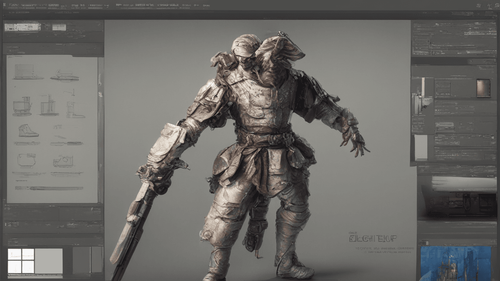
Introduction: Unleashing the Potential of Stable Diffusion Initial Image
In the ever-evolving landscape of digital imagery and data visualization, the concept of stable diffusion initial image has emerged as a game-changer. This intriguing concept, rooted in advanced image processing techniques, holds the promise of transforming how we perceive and manipulate images in various fields, from computer graphics and medical imaging to artistic expression and industrial design.
Understanding Stable Diffusion Initial Image
At its core, stable diffusion initial image is a novel approach to image enhancement and manipulation. Unlike traditional methods that often result in artifacts and distortions, stable diffusion initial image leverages the principles of diffusion processes to achieve smooth and coherent image transformations. By preserving essential details while effectively eliminating noise and inconsistencies, this technique offers a fresh perspective on image editing.
Benefits of Stable Diffusion Initial Image
Enhanced Visual Realism and Clarity
Stable diffusion initial image excels in preserving the natural appearance of images, making it a favored choice in fields like medical imaging and computer graphics. Whether it's capturing intricate anatomical structures or rendering lifelike virtual environments, the technique ensures that every visual element remains faithful to its real-world counterpart.
Artistic Freedom and Expression
In the realm of digital artistry, stable diffusion initial image paves the way for unprecedented creative freedom. Artists and designers can manipulate images with precision, achieving seamless transitions and captivating visual effects. This newfound control over the artistic process fosters innovation and empowers creators to bring their visions to life.
Noise Reduction and Image Restoration
One of the remarkable advantages of stable diffusion initial image is its ability to effectively reduce noise and restore damaged images. In applications where image quality is paramount, such as medical diagnostics, stable diffusion initial image plays a pivotal role in ensuring accurate and reliable results.
Optimized Industrial Design
Industries that rely on image analysis and design, such as manufacturing and architecture, stand to gain from stable diffusion initial image's optimization capabilities. By refining images and enhancing critical details, the technique facilitates informed decision-making and streamlines the design process.
Applications Across Diverse Domains
Medical Imaging Precision
Stable diffusion initial image has found a prominent place in the realm of medical imaging. From detecting subtle abnormalities in X-rays to generating precise three-dimensional reconstructions from MRI scans, the technique contributes to more accurate diagnoses and personalized treatment plans.
Revolutionizing Computer Graphics
Computer graphics enthusiasts embrace stable diffusion initial image for its ability to transform raw renderings into visually stunning masterpieces. Whether it's creating lifelike characters for video games or generating realistic simulations, the technique adds an unparalleled level of realism to digital content.
Architectural Visualization
Architects and urban planners leverage stable diffusion initial image to visualize their design concepts in remarkable detail. By presenting intricate architectural elements and lifelike environments, the technique aids in effective communication with clients and stakeholders.
Industrial Quality Control
In industries where precision is non-negotiable, stable diffusion initial image contributes to enhanced quality control processes. From identifying defects in manufacturing components to analyzing structural integrity, the technique empowers industries to uphold the highest standards of quality.
Implementing Stable Diffusion Initial Image: A Step-by-Step Guide
-
Image Preprocessing: Begin by preparing the input image, ensuring it is properly formatted and ready for enhancement.
-
Diffusion Process Initialization: Initiate the stable diffusion process by defining the initial image and setting relevant parameters.
-
Diffusion Iterations: Apply multiple iterations of the diffusion process, gradually transforming the image while maintaining stability.
-
Convergence Check: Monitor the diffusion process for convergence, ensuring that the desired enhancement level has been achieved.
-
Post-Processing: Fine-tune the enhanced image as needed, adjusting contrast, brightness, and other visual attributes.
Frequently Asked Questions
How does stable diffusion initial image differ from traditional image filters?
Stable diffusion initial image distinguishes itself by its focus on maintaining image stability and coherence throughout the enhancement process. Unlike traditional filters that may introduce artifacts, stable diffusion initial image preserves details and produces more natural-looking results.
Is stable diffusion initial image computationally intensive?
While stable diffusion initial image involves multiple iterations of the diffusion process, advancements in computational techniques have made its implementation feasible for various applications. Modern hardware and optimization algorithms contribute to efficient processing.
Can stable diffusion initial image be combined with other image enhancement methods?
Absolutely. Stable diffusion initial image can complement other enhancement techniques, such as denoising algorithms and contrast adjustments, to achieve even more impressive results. The combination of different methods often leads to synergistic improvements in image quality.
What industries are benefitting the most from stable diffusion initial image?
Stable diffusion initial image finds applications in a wide range of industries, including healthcare, entertainment, design, and manufacturing. Its versatility and ability to enhance images without sacrificing realism make it a valuable asset in diverse domains.
Are there open-source tools available for stable diffusion initial image implementation?
Yes, the research community has contributed to the development of open-source libraries and frameworks that facilitate stable diffusion initial image implementation. These resources empower developers and researchers to explore the technique and integrate it into their projects.
How does stable diffusion initial image contribute to advancements in artificial intelligence?
Stable diffusion initial image plays a role in improving the quality of input data for AI models. By enhancing images used for training, the technique contributes to the accuracy and performance of AI algorithms, leading to more reliable and effective AI systems.
Conclusion
In the realm of digital imagery, stable diffusion initial image stands as a testament to human ingenuity and innovation. Its capacity to enhance images while preserving their inherent characteristics has opened new avenues across industries and creative pursuits. As technology continues to evolve, stable diffusion initial image is poised to shape the future of how we perceive and interact with visual content, leaving an indelible mark on the world of visual expression. Embrace the power of stable diffusion initial image and unlock a realm of possibilities that redefine the boundaries of visual representation.